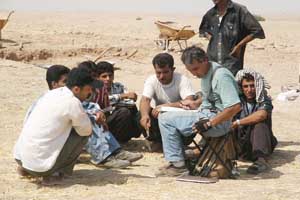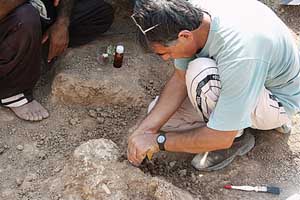Western team allowed in Iran for expedition
By William HarmsNews Office
 Abbas Alizadeh, Senior Research Associate in the Oriental Institute, meets with his archaeological team members during his visit to Khuzestan, Iran, last fall. |
Last fall, Abbas Alizadeh, Senior Research Associate in the Oriental Institute, and Nicholas Kouchoukos, Assistant Professor in Anthropology and the College, visited the archaeologically rich area of Khuzestan, and Alizadeh stayed in Iran to work with local archaeologists on the development of a new research center at the National Museum.
In addition to this work, Alizadeh and his Iranian colleagues organized an August conference in Tehran, which provided a forum to discuss current archaeological research on Iran that specifically focuses on the connections between cultures in the region. The conference, “Ancient Cultural Relations between Iran and West Asia,” drew scholars from around the world, including University representatives.
While in Khuzestan last fall, Alizadeh, Kouchoukos and Tony Wilkinson, Senior Research Associate in the Oriental Institute and an expert on landscapes, studied the region to learn more about ancient fields and the environment and development of land use. Khuzestan is one of the most important archaeological terrains in the ancient Near East and was an integral part of the development of the area’s great civilizations. Work in the region, which the National Science Foundation and the Iranian Cultural Heritage Organization has financed, will resume when a team of University researchers and their colleagues from other countries return in late February 2004, and remain until early April, Alizadeh said.
 Abbas Alizadeh uncovers an artifact at the excavation site in Khuzestan. |
“There are two major revolutions in human history, and both of them are well represented in this area,” said Alizadeh. “The first revolution was the agricultural revolution, in which people gained control over their food supply and began living in villages. The second revolution was the urban revolution in which people developed cities and created the institutions we have today.”
Important changes began in the area in the fourth millennium B.C., when a climatic change brought on a need to create irrigation. Research by the team showed that the plains were periodically flooded, and early farmers probably planted crops in the freshly moistened land, much as Egyptian farmers planted their fields after the flooding of the Nile.
Farmers may have begun channeling water during the time when the area was flooded, and that could have provided knowledge that later led to the building of irrigation canals, the researchers said.
That change in farming practices spurred the development of urban civilization as a greater degree of organization was required to manage irrigation systems than was needed in farming villages using conventional agriculture. The irrigation system in Khuzestan probably developed contemporaneously with the emergence of irrigation in nearby Mesopotamia, which likely connected the people in the two areas, Alizadeh said.
The flooding of the region washed away ancient sites and buried others. Among the sites Alizadeh and his colleagues have found is one that could potentially provide information on the ancient nomads. The nomadic level is about 10 feet below the surface and includes bits of pottery and a level of ashes from the small fires the nomads once used. The team worked with data from other archaeologists who have documented 1,500 sites in the area, and they examined aerial and satellite photographs to study features that are no longer visible because of increased farming and irrigation in the region. In their work, the University team visited and documented more than 300 sites, which produced material being studied in Tehran and Chicago.
“Many of the mega-projects of the ancient Near East were developed in Khuzestan, dams that were the Hoover Dams of their day, for instance,” Kouchoukos said. The region was the home of Elamite culture, which also was known as the Susianan culture, named for Susa, one of the capitals of Elam.
Irrigation and hydro-engineering projects were an important part of the region’s prosperity, and today the area is something of a “California” for Iran, as irrigation and favorable climate make it an excellent agricultural region.
In ancient times, people learned ways of lifting water to irrigate fields that were higher than the irrigation canals; they built impressive dams and canals 166 meters wide; they also routed a channel of water under a river.
The University team was able to confirm that one of the rivers in the region actually runs along a course that was dug for it by an early work force.
Much of the information the team used came from survey work in the field and studying aerial and satellite images. Other information on the developing cultures of the region comes from what are essentially garbage dumps. Fine ceramics were carefully preserved in antiquity, but broken pots and other debris were discarded. This material, which scholars spent decades gathering throughout Iran, is what remains from Neolithic through Islamic times. The shards provide a rich record, however, and can be identified as belonging to a specific period.
Extensive field notes, some compiled by Oriental Institute scholars, provide additional information. Alizadeh and Kouchoukos are assembling the information for a Web site to be launched in September that will make the data widely available.
Alizadeh also has helped organize a Research Center for Archaeological Surveys at the National Museum of Iran in Tehran. Assisting him in the efforts were Kouchoukos and Toby Harnell, a graduate student in Near Eastern Languages & Civilization.
Using a system of identification, which famed University archaeologist Robert McCormick Adams developed during his work in Iran in the 1950s, a team of graduate students worked with museum staff for six months to collect, organize and identify the material. The team also located survey reports that provide additional information about the shards.
Kouchoukos is in charge of organizing the database on the Web for the representation and analysis of archaeological data from excavations, regional surveys and for museum collections.
The material provides important information on the regional structure of societies, settlement patterns, the use of technology and the use of available resources.
![[Chronicle]](/images/sidebar_header_oct06.gif)